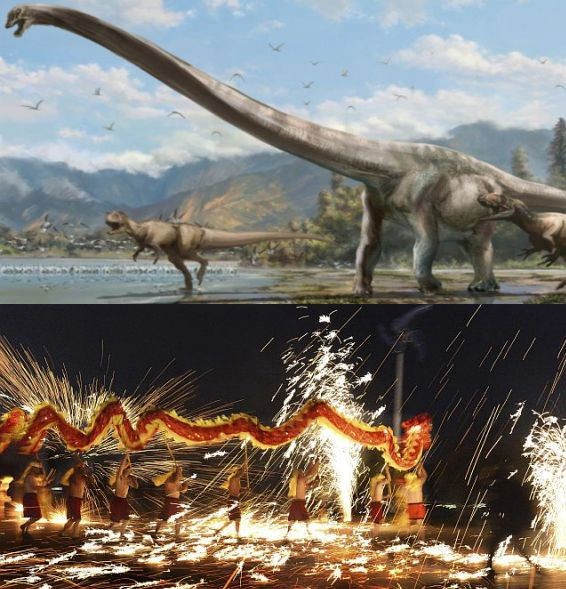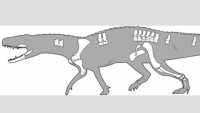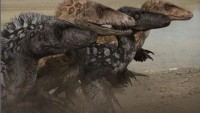Long-Neck Dinosaur in China Clue to Dragons: Scientists
| Raymond Legaspi | | Jan 31, 2015 11:48 AM EST |
(Photo : University of Alberta/Reuters) (Top) University of Alberta paleontologists found a new dinosaur species in China with an elongated neck, shown in this artist's rendition. (Bottom) Folk artists perform a traditional fire dragon dance for the Chinese Lunar New Year on February 1, 2013.
Researchers unearthed the remains of a new species of dinosaur in China with an elongated neck that makes up half its body - somewhat like a giraffe - that could explain the long held belief in dragons.
Paleontologists from the University of Alberta in Canada said if ancient Chinese stumbled upon similar bone fossils, it could have led them to think they were dragons.
Like Us on Facebook
The discovered dinosaur, which included a head still attached to a long neck vertebra, was called Qijianglong. It means "Dragon of Qijiang," named after Qijiang City where the remains were discovered at a construction site in 2006. The skeleton is now housed in a museum in Qijiang.
The find was published recently in the Journal of Vertebrate and credited to prominent paleontologist Philip Currie, together with Tetsuto Miyashita and Lida Xing.
Miyashita said it is rare to find the head still attached to the neck, which only happened in about five per cent of found fossils. The dinosaur's tightly melded spine joints show a rather steady neck that could be easily moved up and down than left to right, just like a building crane.
Researchers said Chinese in the olden days could have gotten the idea of a fire-breathing scaly behemoth with the discovery of dinosaur fossils, adding they would have had a hard time guessing what a long-necked animal like the Qijianglong could be.
They said China's ancient dwellers put the snakes and crocodiles that they were familiar with to imagine legendary, formidable beings like dragons.
Scientists said there are many dinosaur species with elongated necks, but these commonly only make up a third of the body length. The Qijianglong would have had a neck about seven and a half meters high, a species with extreme qualities.
Air filled the neck of the dinosaur to keep the top light. The creature would have lived on land on a diet of plants in the late Jurassic period, around 160 million years ago. Scientists said they probably lived isolated in China because they could not cross an ancient shallow sea around the region.
©2015 Chinatopix All rights reserved. Do not reproduce without permission
EDITOR'S PICKS
-

Did the Trump administration just announce plans for a trade war with ‘hostile’ China and Russia?
-

US Senate passes Taiwan travel bill slammed by China
-

As Yan Sihong’s family grieves, here are other Chinese students who went missing abroad. Some have never been found
-

Beijing blasts Western critics who ‘smear China’ with the term sharp power
-

China Envoy Seeks to Defuse Tensions With U.S. as a Trade War Brews
-

Singapore's Deputy PM Provides Bitcoin Vote of Confidence Amid China's Blanket Bans
-

China warns investors over risks in overseas virtual currency trading
-

Chinese government most trustworthy: survey
-

Kashima Antlers On Course For Back-To-Back Titles
MOST POPULAR
LATEST NEWS
Zhou Yongkang: China's Former Security Chief Sentenced to Life in Prison

China's former Chief of the Ministry of Public Security, Zhou Yongkang, has been given a life sentence after he was found guilty of abusing his office, bribery and deliberately ... Full Article
TRENDING STORY

China Pork Prices Expected to Stabilize As The Supplies Recover

Elephone P9000 Smartphone is now on Sale on Amazon India

There's a Big Chance Cliffhangers Won't Still Be Resolved When Grey's Anatomy Season 13 Returns

Supreme Court Ruled on Samsung vs Apple Dispute for Patent Infringement

Microsoft Surface Pro 5 Rumors and Release Date: What is the Latest?













